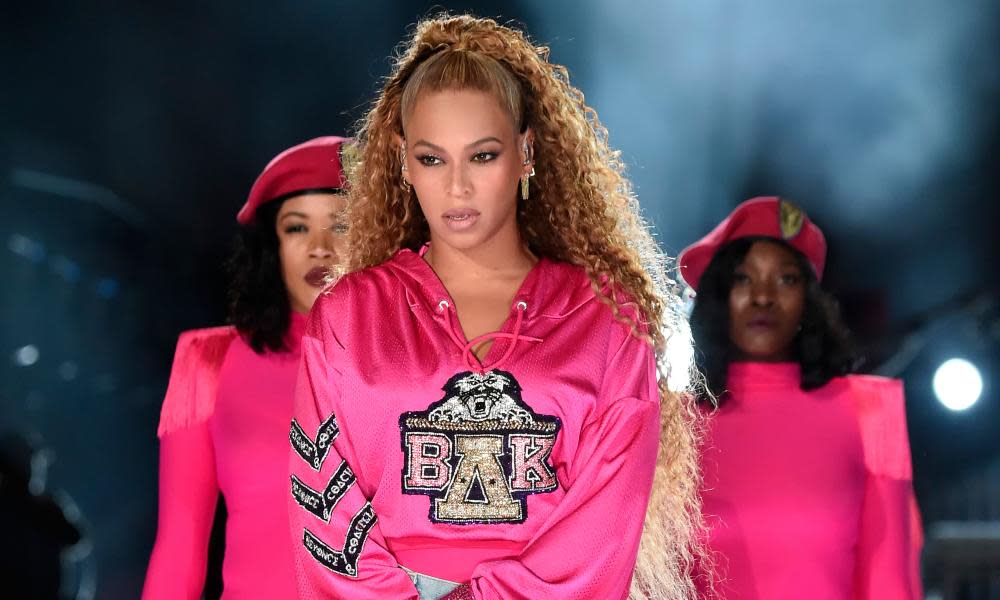Beyoncé, Coachella 2018: a rich tapestry of black cultural excellence

If Beyoncé’s fanbase, the Beyhive, is something of a cult, then her live performances are their holy pilgrimage. Although I had been on three previously, in Boston, Amsterdam and London, I felt relieved when she had to cancel her Coachella performances in 2017 due to her pregnancy – there was no way I could afford to get myself to Los Angeles, let alone buy a ticket.
Fellow Beyhivers half-joke that her shows are like going to church, and by the time of her rescheduled Coachella date in 2018 – becoming the first black woman to headline the festival – it felt like the return of the messiah. By some divine miracle, a friend who had an artist performing at Coachella added me to their entourage as a “backing dancer”. The desert air was cool, but there was a hot rising giddiness in the crowd, mixed with musky clouds that some were exhaling. The festival’s proximity to LA’s celebrity bubble gives it a glittery, superficial vibe; everyone thinks they are a star or can at least buy their way into the VIP area. But even the most faux-nonchalant influencer was having their chill eroded by anticipation.

The pressure in the audience burst to the sound of marching drums, as the stage was filled with a complete band, and Beyoncé was revealed on a catwalk with a royal headdress and a long sparkling cape with Queen Nefertiti emblazoned on the back, flanked by furiously fit dancers wearing catsuits featuring imagery of the sphinx. Olivier Rousteing, Balmain’s creative director, later described designing the costumes as “the biggest challenge of my life”– the stage was filled with the most visually rich, symbolic imagery we’d seen since her Superbowl performance two years previously.
She changed into a yellow hoodie with the letters BAK sparkling across her chest, a tribute to the Divine Nine, black fraternities and sororities founded at historically black colleges and universities (HBCUs) in America. By wearing Balmain’s take on the hoodies worn by their members, Beyoncé was centring a part of African-American culture not often seen in the mainstream. Every detail, more than just a random aesthetic choice, dripped in meaning.
She teamed the hoodie with denim hotpants, evocative of the iconic video to her 2003 breakthrough solo hit Crazy in Love, the opening song on the soundtrack to the millennial woman’s journey from girlhood, and first track to the show. Performing Drunk in Love, Beyoncé towered above the crowd on a contraption that looked like a ladder to heaven, and it really did feel like a spiritual experience. She looked like an angel, and the music itself (later released as a live album) felt celestial. Her entire discography was reworked with live instrumentation, and enhancing the jazz tones via the brass gave it a timeless feel. It felt like a richer, more unified body of work, the ultimate best-of compilation; she had added hot sauce to the original songs.
Later, the mood darkened as she came out in a black latex bodysuit with matching thigh-high boots and jacket, heralding the rock’n’roll moment of the show – think Prince performing Purple Rain or Michael Jackson’s Bad. Don’t Hurt Yourself, co-produced by Jack White, had Malcolm X’s words ring out at the end: “The most disrespected person in America is the black woman. The most unprotected person in America is the black woman.” This segued into I Care, a power ballad with an 80s feel with impressive rock vocals, synth sounds, dancers in zebra-print two pieces and a guitar solo: an epic throwback to another period in black musical excellence.
Jay-Z and J Balvin appeared as hype men – I remember wondering if Sean Paul felt cheated for not performing Baby Boy – but Destiny’s Child were the guest stars that stole the show, and the charged crowd belted out Say My Name. Nostalgia peaked again when her sister Solange recreated the moment they shared on stage during Solange’s Coachella set in 2014: fun and a little less tightly choreographed than the rest of the show.
She had scaled the peak of her performing career, to say something bigger than herself
I went to both weekends (I know, ridiculous) and although the first week was the true homecoming, the second was a better, smoother performance. Both were edited together for Netflix documentary Homecoming, with colour and commentary from Beyoncé herself on her vision for the show: “I always dreamed of going to an HBCU,” she said. “My college was Destiny’s Child. My college was travelling around the world, and life was my teacher.”
Words from HBCU alumni such as Toni Morrison, WEB DuBois and Marian Wright Edelman were quoted, woven into a rich tapestry of intellectual, creative black culture. She also described how difficult it was to get into the shape she wanted to be in for the show with her post-natal regime: a humanising struggle of an artist and a mother, who is held up in the eyes of her fans as superhuman. She confessed: “I will never push myself that far again.” The honesty of her personal struggle – tied in with the collective historical struggle of black people, and black women in particular – was extremely powerful.
Live music at its best makes you feel connected both to the performer and the crowd, fully in the present moment – I remember feeling a fluid joy that flowed across the other emotions during the show. But I also sensed that it was a moment in history, that I would never see a show like this again, not even at another Beyoncé concert. She had scaled the peak of her performing career, to say something bigger than herself: “Instead of pulling out my flower crown, it was more important that I brought our culture to Coachella.”

 Yahoo News
Yahoo News 
